Yamnaya culture
 | |
| Alternative names |
|
|---|---|
| Geographical range | Pontic–Caspian steppe in Europe |
| Period | Copper Age, Bronze Age |
| Dates | c. 3300 – 2600 BCE |
| Preceded by | Samara culture, Khvalynsk culture, Dnieper–Donets culture, Sredny Stog culture, Repin culture, Maykop culture, Cucuteni–Trypillia culture, Cernavodă culture, Usatove culture |
| Followed by | North: Corded Ware culture [1]
West: Catacomb culture, Vučedol culture East: Poltavka culture |
| Defined by | Vasily Gorodtsov |
The Yamnaya culture
The Yamnaya economy was based upon
Genetic studies have suggested that the people of the Yamnaya culture can be modelled as a
According to the widely-accepted
Origins
The Yamnaya culture was defined by Vasily Gorodtsov in order to differentiate it from the Catacomb and Srubnaya cultures that existed in the area, but were considered to be of a later period. Due to the time interval to the Yamnaya culture, and the reliance on archaeological findings, debate as to its origin is ongoing.[18] In 1996, Pavel Dolukhanov suggested that the emergence of the Pit-Grave culture represents a social development of various different local Bronze Age cultures, thus representing "an expression of social stratification and the emergence of chiefdom-type nomadic social structures" which in turn intensified inter-group contacts between essentially heterogeneous social groups.[19]
The origin of the Yamnaya culture continues to be debated, with proposals for its origins pointing to both the Khvalynsk and Sredny Stog cultures.[18] The Khvalynsk culture (4700–3800 BCE)[20] (middle Volga) and the Don-based Repin culture (c. 3950–3300 BCE)[21] in the eastern Pontic-Caspian steppe, and the closely related Sredny Stog culture (c. 4500–3500 BCE) in the western Pontic-Caspian steppe, preceded the Yamnaya culture (3300–2500 BCE).[22][23]

Further efforts to pinpoint the location came from Anthony (2007), who suggested that the Yamnaya culture (3300–2600 BCE) originated in the
He argues that the early Yamnaya horizon spread quickly across the Pontic–Caspian steppes between c. 3400 and 3200 BCE:[24]
The spread of the Yamnaya horizon was the material expression of the spread of late Proto-Indo-European across the Pontic–Caspian steppes.[26]
[...] The Yamnaya horizon is the visible archaeological expression of a social adjustment to high mobility – the invention of the political infrastructure to manage larger herds from mobile homes based in the steppes.[27]
Alternatively, Parpola (2015) relates both the Corded ware culture and the Yamnaya culture to the late
The Yamnaya culture was succeeded in its western range by the
- Maps of the origins of Yamnaya culture
-
Sredny Stog culture (c.4500-3500 BCE)
-
Usatovo culture (c. 3500–3000 BCE)
-
Khvalynsk culture (c. 4900–3500 BCE)
-
Early Yamnaya culture (3400 BCE), according to Anthony (2007)
Characteristics

The Yamnaya culture was nomadic[4] or semi-nomadic, with some agriculture practiced near rivers, and a few fortified sites, the largest of which is Mikhaylivka.[32]
Characteristic for the culture are the
The Yamnaya culture had and used two-wheeled carts and four-wheeled wagons, which are thought to have been oxen-drawn at this time, and there is evidence that they rode horses.[38][39] For instance, several Yamnaya skeletons exhibit specific characteristics in their bone morphology that may have been caused by long-term horseriding.[38]
Metallurgists and other craftsmen are given a special status in Yamnaya society, and metal objects are sometimes found in large quantities in elite graves. New metalworking technologies and weapon designs are used.[36]
Stable isotope ratios of Yamna individuals from the Dnipro Valley suggest the Yamnaya diet was terrestrial protein based with insignificant contribution from freshwater or aquatic resources.[40] Anthony speculates that the Yamnaya ate meat, milk, yogurt, cheese, and soups made from seeds and wild vegetables, and probably consumed mead.[41]
Mallory and Adams suggest that Yamnaya society may have had a tripartite structure of three differentiated social classes, although the evidence available does not demonstrate the existence of specific classes such as priests, warriors, and farmers.[42]
Gallery
-
Corded ware pot
-
Daggers, arrowheads and bone artefacts
-
Yamanaya decorative artifacts.
-
The Kernosivsky idol (late Yamnaya)
-
Western Yamnaya artefacts
-
Illustration of a Yamnaya wagon
-
Yamnaya burials from Moldova
-
Metal artefacts from Russia
-
Silver and gold jewellery from Bulgaria
-
Artefacts from theNorthern Caucasus, 3rd millennium BCE
-
Ceramic vessel
-
Cis-Ural Yamnaya artefacts and burials
-
Horses were domesticated on the Pontic-Caspian steppe.[43]
-
Yamnaya artefacts from the steppe-Urals, early (1) and late (2)
Archaeogenetics
According to Jones et al. (2015) and Haak et al. (2015),

Admixture between EHGs and CHGs is believed to have occurred on the eastern Pontic-Caspian steppe starting around 5,000 BCE, while admixture with
People of the Yamnaya culture are believed to have had mostly brown eye colour, light to intermediate skin, and brown hair colour, with some variation.[55][56]
Some Yamnaya individuals are believed to have carried a mutation to the KITLG gene associated with blond hair, as several individuals with Steppe ancestry are later found to carry this mutation. The Ancient North Eurasian Afontova Gora group, who contributed significant ancestry to Western Steppe Herders, are believed to be the source of this mutation.[57] A study in 2015 found that Yamnaya had the highest ever calculated genetic selection for height of any of the ancient populations tested.[58][59] It has been hypothesized that an allele associated with lactase persistence (conferring lactose tolerance into adulthood) was brought to Europe from the steppe by Yamnaya-related migrations.[60][61][62][63]

A 2022 study by Lazaridis et al. found that the typical phenotype among the Yamnaya population was brown eyes, brown hair, and intermediate skin colour. None of their Yamnaya samples were predicted to have either blue eyes or blond hair, in contrast with later Steppe groups in Russia and Central Asia, as well as the Bell Beaker culture in Europe, who did carry these phenotypes in high proportions.[64]
The geneticist David Reich has argued that the genetic data supports the likelihood that the people of the Yamnaya culture were a "single, genetically coherent group" who were responsible for spreading many Indo-European languages.[65] Reich's group recently suggested that the source of Anatolian and Indo-European subfamilies of the Proto-Indo-European (PIE) language may have been in west Asia and the Yamna were responsible for the dissemination of the latter.[9] Reich also argues that the genetic evidence shows that Yamnaya society was an oligarchy dominated by a small number of elite males.[66]
The genetic evidence for the extent of the role of the Yamnaya culture in the spread of Indo-European languages has been questioned by Russian archaeologist Leo Klejn[67] and Balanovsky et al.,[68] who note a lack of male haplogroup continuity between the people of the Yamnaya culture and the contemporary populations of Europe. Klejn has also suggested that the autosomal evidence does not support a Yamnaya migration, arguing that Western Steppe Herder ancestry in both contemporary and Bronze Age samples is lowest around the Danube in Hungary, near the western limits of the Yamnaya culture, and highest in Northern Europe, which Klejn argues is the opposite of what would be expected if the geneticists' hypothesis is correct.[69]
Language


According to David W. Anthony, the genetic evidence suggests that the leading clans of the Yamnaya were of EHG (Eastern European hunter-gatherer) and WHG (Western European hunter-gatherer) paternal origin[74] and implies that the Indo-European languages were the result of "a dominant language spoken by EHGs that absorbed Caucasus-like elements in phonology, morphology, and lexicon."[75] It has also been suggested that the PIE language evolved through trade interactions in the circum-Pontic area in the 4th millennium BCE, mediated by the Yamna predecessors in the North Pontic steppe.[76]
Guus Kroonen et al. 2022 found that the "basal Indo-European stage", also known as
Western Europe
Genetic studies have found that Yamnaya autosomal characteristics are very close to the
However, according to Heyd, et al. (2023), the specific paternal DNA haplogroup that is most commonly found in male Yamnaya specimens cannot be found in modern Western Europeans, or in males from the nearby Corded Ware culture. This makes it unlikely that the Corded Ware culture can be directly descended from the Yamnaya culture, at least along the paternal line.[80]
Autosomal tests also indicate that the Yamnaya are the vector for "Ancient North Eurasian" admixture into Europe.[10] "Ancient North Eurasian" is the name given in literature to a genetic component that represents descent from the people of the Mal'ta–Buret' culture[10] or a population closely related to them. That genetic component is visible in tests of the Yamnaya people[10] as well as modern-day Europeans. [81]
Eastern Europe and Finland
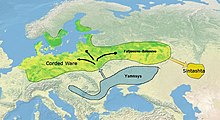
In the Baltic, Jones et al. (2017) found that the Neolithic transition – the passage from a hunter-gatherer economy to a farming-based economy – coincided with the arrival en masse of individuals with Yamnaya-like ancestry. This is different from what happened in Western and Southern Europe, where the Neolithic transition was caused by a population that came from Anatolia, with Pontic steppe ancestry being detected from only the late Neolithic onward.[82]
Per Haak et al. (2015), the Yamnaya contribution in the modern populations of Eastern Europe ranges from 46.8% among Russians to 42.8% in Ukrainians. Finland has the highest Yamnaya contributions in all of Europe (50.4%).[83][e]
Central and South Asia
Studies also point to the strong presence of Yamnaya descent in the current nations of South Asia, especially in groups that are referred to as Indo-Aryans.
According to Unterländer et al. (2017), all Iron Age
See also
Notes
- ^ /ˈjæmnaɪə/ YAM-ny-yə; Russian: Ямная культура, romanized: Yámnaya kultúra, pronounced [ˈjamnəjə kʊlʲˈturə], from яма "pit, hole"
- ^ /ˈjæmnə/ YAM-nə; Ukrainian: Ямна культура, romanized: Jamna kuľtura, Ukrainian pronunciation: [ˈjamnɐ kʊlʲˈturɐ], lit. 'culture of pits'
- ^ Yamnayan cultural aspects, for example, were horse-riding, burial styles, and to some extent the pastoralist economy.
- ^ The Eastern European hunter-gatherers were themselves mostly descended from ancient North Eurasians, related to the palaeolithic Mal'ta–Buret' culture.
- ^ Per Haak et al. (2015), adding a north-Siberian people as a fourth reference population improves residuals for northeastern European populations. This accounts for the higher than expected Yamnaya contribution and brings it down to expected levels (67.8–50.4 % in Finns, 64.9–46.8 % in Russians).
- ^ Lazaridis et al. (2016) Supplementary Information, Table S9.1: "Kalash – 50.2 %, Tiwari Brahmins – 44.1 %, Gujarati (four samples) – 46.1 % to 27.5 %, Pathan – 44.6 %, Burusho – 42.5 %, Sindhi – 37.7 %, Punjabi – 32.6 %, Balochi – 32.4 %, Brahui – 30.2 %, Lodhi – 29.3 %, Bengali – 24.6 %, Vishwabhramin – 20.4 %, Makrani – 19.2 %, Mala – 18.4 %, Kusunda – 8.9 %, Kharia – 6.5 %."
References
- ^ a b c Allentoft 2015.
- ^ a b c Morgunova & Khokhlova 2013.
- ISBN 978-1-00-926175-3, retrieved 2023-05-23
- ^ ISBN 978-1-00-926175-3, retrieved 2023-05-13
- ^ Novembre 2015, "evidence to support theories of a back-migration from Corded Ware-related populations that contributed to the origins of the Sintashta culture in the Urals and their descendants, the Andronovo."
- S2CID 225136827.
- ^ a b c "Europe's fourth ancestral 'tribe' uncovered". BBC. 16 November 2015.
- PMID 30713341.
- ^ S2CID 251843620.
- ^ a b c d e f Haak et al. 2015.
- ^ a b c Mathieson, et al. 2015.
- ^ a b Gibbons, Ann (10 June 2015). "Nomadic herders left a strong genetic mark on Europeans and Asians". Science. AAAS.
- S2CID 7459815.
- PMID 28235025.
- ^ Anthony 2007, p. 300-370.
- ^ Nordgvist & Heyd 2020.
- ^ Mallory 1999.
- ^ a b Mallory 1999, p. 215.
- ^ Dolukhanov 1996, p. 94.
- ^ Anthony 2007, p. 182.
- ^ a b Anthony 2007, p. 275.
- ^ Anthony 2007, p. 300.
- ^ Mallory 1999, p. 210-211.
- ^ a b Anthony 2007, p. 321.
- ^ Anthony 2007, pp. 274–277, 317–320.
- ^ Anthony 2007, pp. 301–302.
- ^ Anthony 2007, p. 303.
- ^ Parpola 2015, p. 49.
- ^ Parpola 2015, p. 45.
- ^ Parpola 2015, p. 47.
- ^ Telegin, D. Y. (1973). Serednʹo-stohivsʹka kulʹtura epokhy midi. Kyiv: Naukova Dumka. p. 147.
- ^ Mallory 1997, p. 212.
- ^ Anthony 2007, p. 339.
- ^ Anthony 2007, p. 319.
- OCLC 1102387902.
- ^ )
- ^ Anthony 2007, p. 305.
- ^ S2CID 257334477.
- )
- ISBN 978-3-11-031121-1.
- ^ Anthony 2007, p. 430.
- OCLC 37931209.
- PMID 34671162.
- PMID 32621306.
- ^ Jones et al. 2015.
- ^ a b Lazaridis et al. 2016.
- S2CID 251843620.
- PMID 35635751.
- PMID 30713341.
- ^ Balanovsky 2017, p. 437.
- ^ Wang 2019.
- OCLC 1234973657.
- PMID 30235269.
- S2CID 7459815. "In the 12 successfully haplotyped specimens, 75% of mtDNA lineages consisted of west Eurasian haplogroup U and its U4 and U5 sublineages. Furthermore, we identified a subgroup of east Eurasian haplogroup C in two representatives of the Yamna culture in one of the studied kurgans."
- PMID 26206910.
- PMID 32621306.
- PMID 29466330.
- S2CID 164376362.
- PMID 26595274.
- PMID 32511234. "Furthermore, ancient DNA studies found that the LP mutation was absent or very rare in Europe until the end of the Bronze Age [26–29] and appeared first in individuals with steppe ancestry [19,20]. Thus, it was proposed that the mutation originated in Yamnaya-associated populations and arrived later in Europe by migration of these steppe herders."
- ^ Callaway, Ewen. "DNA data explosion lights up the Bronze Age". Nature. "the 101 sequenced individuals, the Yamnaya were most likely to have the DNA variation responsible for lactose tolerance, hinting that the steppe migrants might have eventually introduced the trait to Europe"
- . "For example, one lineage could have a biological evolutionary advantage over the other. Allentoft et al. (2015: 171) have found a remarkably high rate of lactose tolerance among individuals connected to Yamnaya and to Corded Ware, as opposed to the majority of Late Neolithic individuals."
- S2CID 226229587.
- ^ Lazaridis et al. 2022c.
- OCLC 1006478846.)
{{cite book}}: CS1 maint: location missing publisher (link - OCLC 1006478846.)
{{cite book}}: CS1 maint: location missing publisher (link - .
- S2CID 3735168. "The ancient Yamnaya samples are located on the "eastern" R-GG400 branch of haplogroup R1b-L23, showing that the paternal descendants of the Yamnaya still live in the Pontic steppe and that the ancient Yamnaya population was not an important source of paternal lineages in present-day West Europeans."
- ^ Klejn 2017, p. 201: "In the tables presented in the article by Reichs’ team (Haak et al. 2015) the genetic pool connecting the Yamnaya culture with the Corded Ware people is shown to be more intense in Northern Europe (Norway and Sweden) and decreases gradually from the North to the South (Fig. 6). It is weakest around the Danube, in Hungary, i. e. areas neighbouring the western branch of the Yamnaya culture! This is the reverse image to what the proposed hypothesis by the geneticists would lead us to expect. It is true that this gradient is traced back from the contemporary materials, but it was already present during the Bronze Age [...]"
- ^ a b Zimmer, Carl (10 June 2015). "DNA Deciphers Roots of Modern Europeans". New York Times. Retrieved 2020-12-12.
- S2CID 202354040
- ISBN 978-1-00-926175-3, retrieved 2023-05-13
- ISBN 978-3-643-91507-8.
- ^ Anthony 2019b, p. 36.
- ^ Anthony 2019a, p. 1-19.
- .
- PMID 36223379.
- PMID 36649433.
- ^ Haak et al. 2015, pp. 121–124.
- ISBN 978-1-009-26174-6.
- ^ Lazaridis et al. 2014.
- ^ Jones et al. 2017.
- ^ Haak et al. 2015, pp. 121–122.
- ^ a b Narasimhan et al. 2019.
- ^ a b Pathak et al. 2018.
- ^ Unterländer et al. 2017Genomic inference reveals that Scythians in the east and the west of the steppe zone can best be described as a mixture of Yamnaya-related ancestry and an East Asian component. Demographic modelling suggests independent origins for eastern and western groups with ongoing gene-flow between them, plausibly explaining the striking uniformity of their material culture. We also find evidence that significant gene-flow from east to west Eurasia must have occurred early during the Iron Age." and "The blend of EHG [European hunter-gatherer] and Caucasian elements in carriers of the Yamnaya culture was formed on the European steppe and exported into Central Asia and Siberia". We therefore considered an alternative model in which we treat them as a mix of Yamnaya and the Han (Supplementary Table 25). This model fits all of the Iron Age Scythian groups, consistent with these groups having ancestry related to East Asians not found in the other populations. Alternatively, the Iron Age Scythian groups can also be modelled as a mix of Yamnaya and the north Siberian Nganasan (Supplementary Note 2, Supplementary Table 26).
Sources
- Allentoft, Morten E.; et al. (2015). "Population genomics of Bronze Age Eurasia". S2CID 4399103.
- ISBN 978-0-691-05887-0.
- Anthony, David (2017). "Archaeology and Language: Why Archaeologists Care About the Indo-European Problem". In Crabtree, P.J.; Bogucki, P. (eds.). European Archaeology as Anthropology: Essays in Memory of Bernard Wailes.
- Anthony, David (Spring–Summer 2019a). "Archaeology, Genetics, and Language in the Steppes: A Comment on Bomhard". Journal of Indo-European Studies. 47 (1–2). Retrieved 2020-01-09.
- ISBN 978-9004416192.
- Cassidy LM, Martiniano R, Murphy EM, Teasdale MD, Mallory J, Hartwell B, Bradley DG (2016). "Neolithic and Bronze Age migration to Ireland and establishment of the insular Atlantic genome". PNAS. 113 (2): 368–373. PMID 26712024.
- Dolukhanov, Pavel M. (1996), The Early Slavs: Eastern Europe from the Initial Settlement to the Kievan Rus, New York: Longman, ISBN 0-582-23627-4
- Fortson, Benjamin W. (2004), Indo-European Language and Culture: An Introduction, Blackwell Publishing
- Gallego-Llorente M, Connell S, Jones ER, Merrett DC, Jeon Y, Eriksson A, et al. (2016). "The genetics of an early Neolithic pastoralist from the Zagros, Iran". PMID 27502179.
- Haak W, Lazaridis I, Patterson N, Rohland N, Mallick S, Llamas B, et al. (2015). "Massive migration from the steppe was a source for Indo-European languages in Europe". Nature. 522 (7555): 207–211. PMID 25731166.
- Jeong, Choongwon; Balanovsky, Oleg; Lukianova, Elena; Kahbatkyzy, Nurzhibek; et al. (29 April 2019). "The genetic history of admixture across inner Eurasia languages in Europe". PMID 31036896.
- Jones, Eppie R.; Gonzalez-Fortes, Gloria; Connell, Sarah; Siska, Veronika; et al. (2015). "Upper Palaeolithic genomes reveal deep roots of modern Eurasians". PMID 26567969.
- Jones ER, Zarina G, Moiseyev V, Lightfoot E, Nigst PR, Manica A, Pinhasi R, Bradley DG (2017). "The Neolithic transition in the Baltic was not driven by admixture with early European farmers". PMID 28162894.
- ISBN 978-9004160545.
- Lazaridis, Iosif; Patterson, Nick; Mittnik, Alissa; Renaud, Gabriel; et al. (2014). "Ancient human genomes suggest three ancestral populations for present-day Europeans". PMID 25230663.
- Lazaridis I, Nadel D, Rollefson G, Merrett DC, Rohland N, Mallick S, et al. (16 June 2016). "The genetic structure of the world's first farmers". bioRxiv 10.1101/059311. Supplementary Information
- Lazaridis I, Nadel D, Rollefson G, Merrett DC, Rohland N, Mallick S, et al. (25 July 2016). "Genomic insights into the origin of farming in the ancient Near East". Nature. 536 (7617) (published August 2016): 419–424. PMID 27459054.
- Lazaridis, Iosif; Alpaslan-Roodenberg, Songül; Acar, Ayşe; Açıkkol, Ayşen; Agelarakis, Anagnostis; Aghikyan, Levon; Akyüz, Uğur; Andreeva, Desislava; Andrijašević, Gojko; Antonović, Dragana; Armit, Ian; Atmaca, Alper; Avetisyan, Pavel; Aytek, Ahmet İhsan; Bacvarov, Krum (26 August 2022). "A genetic probe into the ancient and medieval history of Southern Europe and West Asia". Science. 377 (6609): 940–951. S2CID 251844202.
- Mallory, J. P. (1997), "Yamna Culture", Encyclopedia of Indo-European Culture, Fitzroy Dearborn
- ISBN 978-0-500-27616-7
- Martiniano, R, et al. (2017). "The population genomics of archaeological transition in west Iberia: Investigation of ancient substructure using imputation and haplotype-based methods". PLOS Genet. 13 (7): e1006852. PMID 28749934.
- Mathieson, Iain; et al. (10 October 2015). "Eight thousand years of natural selection in Europe". PMID 26595274.
- Mathieson, Iain; et al. (21 February 2018). "The Genomic History of Southeastern Europe". PMID 29466330.
- Morgunova, Nina; Khokhlova, Olga (2013). "Chronology and Periodization of the Pit-Grave Culture in the Area Between the Volga and Ural Rivers Based on 14C Dating and Paleopedological Research". Radiocarbon. 55 (2–3): 1286–1296. ISSN 0033-8222.
- Narasimhan VM, Patterson N, Moorjani P, Rohland N, et al. (2019). "The formation of human populations in South and Central Asia". Science. 365 (6457): eaat7487. PMID 31488661.
- Nordgvist, Kerkko; Heyd, Volker (2020). "The Forgotten Child of the Wider Corded Ware Family: Russian Fatyanovo Culture in Context". Proceedings of the Prehistoric Society. 86: 65–93. S2CID 228923806.
- Novembre, John (11 June 2015). "Ancient DNA steps into the language debate". Nature. 522 (7555): 164–165. S2CID 205085294.
- Parpola, Asko (2015), The Roots of Hinduism, Oxford University Press
- Pashnick, Jeff (August 2014). Genetic Analysis of Ancient Human Remains from the Early Bronze Age Cultures of the North PonticSteppe Region (Masters Theses thesis). Vol. 737. Grand Valley State University. Retrieved 2020-01-12.
- Pathak AK, Kadian A, Kushniarevich A, Montinaro F, Mondal M, Ongaro L, et al. (6 December 2018). "The Genetic Ancestry of Modern Indus Valley Populations from Northwest India". The American Journal of Human Genetics. 103 (6): 918–929. PMID 30526867.
- Unterländer, Martina; Palstra, Friso; Lazaridis, Iosif; Pilipenko, Aleksandr; Hofmanová, Zuzana; Groß, Melanie; et al. (2017). "Ancestry and demography and descendants of Iron Age nomads of the Eurasian Steppe". Nature Communications. 8: 14615. PMID 28256537.
- Wang, Chuan-Chao (4 February 2019). "Ancient human genome-wide data from a 3000-year interval in the Caucasus corresponds with eco-geographic regions Eurasia". PMID 30713341.
- Wilde S, Timpson A, Kirsanow K, Kaiser E, Kayser M, Unterländer M, et al. (2014). "Direct evidence for positive selection of skin, hair, and eye pigmentation in Europeans during the last 5,000 y". PMID 24616518.
External links
- "Genetic study revives debate on origin and expansion of Indo-European Languages". Science Daily. March 2015.
- "First Horse Warriors". PBS.org NOVA series. 15 May 2019.


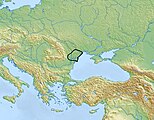

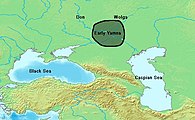




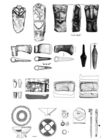

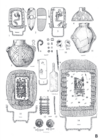





![Horses were domesticated on the Pontic-Caspian steppe.[43]](http://upload.wikimedia.org/wikipedia/commons/thumb/7/7f/Wild_horses_in_Rostovsky_nature_reserve.jpg/140px-Wild_horses_in_Rostovsky_nature_reserve.jpg)
